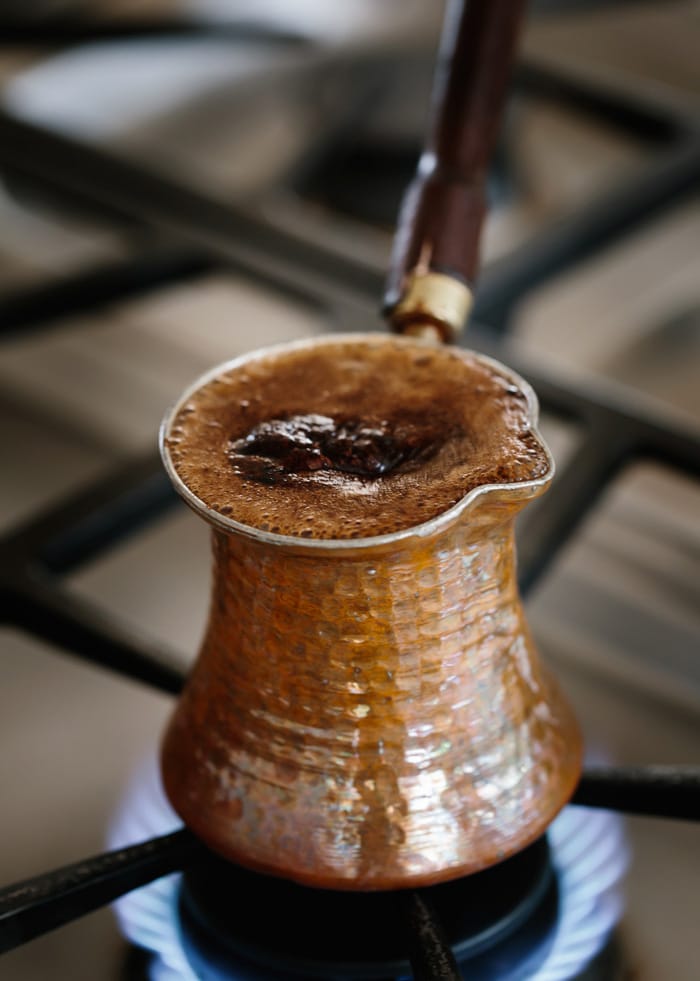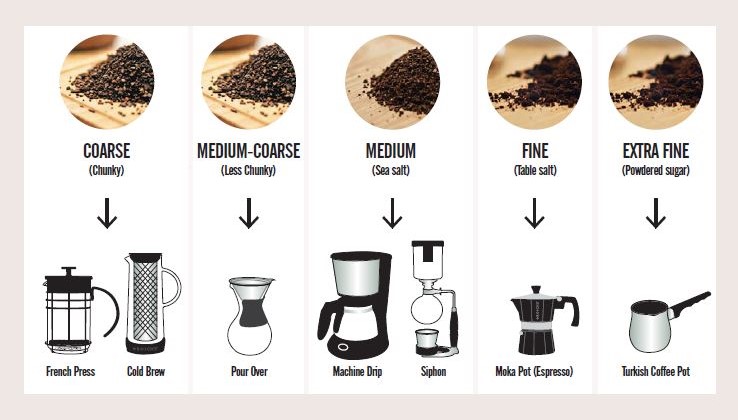As an Amazon Associate CoffeeXplore.com earns from qualifying purchases.
How to Make Turkish Coffee Without a Cezve: Easy Guide
Turkish coffee, with its rich aroma and velvety texture, has captivated coffee lovers worldwide. But what if you don’t have the traditional cezve? Can you still enjoy this beloved brew?
Many coffee enthusiasts find themselves frustrated, longing for the authentic taste of Turkish coffee but lacking the proper equipment. Is it possible to recreate this centuries-old tradition with everyday kitchen tools?
Yes, you can make Turkish coffee in a regular pot. While a cezve (ibrik) is traditionally used, a small saucepan or pot can be adapted to brew a satisfying cup of Turkish coffee with careful attention to technique and temperature control.
Curious about how to transform your ordinary pot into a Turkish coffee marvel? Stick around as we unveil the secrets to brewing this rich, aromatic beverage using common kitchen tools. As a coffee expert who’s experimented with various brewing methods, I’ll guide you through the process, sharing tips and tricks to achieve that perfect cup of Turkish coffee, no matter what equipment you have on hand.
Key Facts:
– Turkish coffee is traditionally brewed in a special pot called a cezve or ibrik.
– The coffee grounds used for Turkish coffee are extremely fine, almost powder-like.
– Turkish coffee is known for its thick foam, called “kaimaki,” which is considered essential to the experience.
– The brewing process for Turkish coffee involves bringing the mixture to a near-boil multiple times.
– Turkish coffee is typically served unfiltered, with the grounds settling at the bottom of the cup.
Understanding Traditional Turkish Coffee Preparation
The Importance of the Cezve
Turkish coffee, a cornerstone of Turkish culture and cuisine, is traditionally prepared using a special pot called a cezve (also known as ibrik). The cezve is a small, long-handled pot typically made of copper or brass, designed specifically for brewing Turkish coffee and creating its signature foam.
The unique design of the cezve plays a crucial role in the traditional preparation of Turkish coffee. Its narrow top helps concentrate the coffee’s aroma and facilitates the formation of the cherished foam. The long handle allows for precise control during the brewing process, which is essential for achieving the perfect cup.
While the cezve is the ideal tool for making Turkish coffee, it’s not the only way to enjoy this rich, aromatic beverage. As we’ll explore in the next section, it’s possible to adapt the brewing method for use with regular kitchen equipment.

Traditional Turkish coffee setup with cezve and serving cups Source
Brewing Turkish Coffee Without a Cezve
Can you recreate the magic of Turkish coffee without the traditional cezve? Yes, it’s possible to brew Turkish coffee using a regular pot or small saucepan, although the process requires some adjustments and careful attention to detail.
When using a regular pot instead of a cezve, the key differences lie in heat control and foam formation. A cezve’s design allows for precise temperature management and easy foam creation, while a regular pot may require more skill to achieve similar results.
Here’s a comparison of the traditional cezve method versus using a regular pot:
| Aspect | Cezve | Regular Pot |
|---|---|---|
| Heat Control | Precise due to small size and material | Requires more attention |
| Foam Formation | Easier to achieve | More challenging, but possible |
| Serving Size | Perfect for small batches | May be better for larger quantities |
| Authenticity | Traditional method | Adapted method |
While using a regular pot may not produce exactly the same results as a cezve, with practice and attention to detail, you can still brew a delicious cup of Turkish coffee. The key is to focus on the fundamental aspects of Turkish coffee brewing: fine grounds, the right coffee-to-water ratio, and careful heat management.
Can You Make Turkish Coffee in a Regular Pot?
Yes, you can make Turkish coffee in a regular pot. To do so, simply use finely ground coffee, cold water, and sugar if desired. Heat the mixture slowly over medium heat until foam forms, then pour and serve.
Gathering Your Ingredients and Equipment
To make Turkish coffee in a regular pot, you’ll need to assemble the right ingredients and tools. The essential ingredients for Turkish coffee are finely ground coffee beans, water, and sugar (if desired). For equipment, you’ll need a small pot or saucepan, a spoon for stirring, and small cups for serving.
Here’s a detailed list of what you’ll need:
- Finely ground Turkish coffee: The grind should be extremely fine, almost powder-like. Turkish coffee beans are traditionally dark roasted, but you can experiment with different roasts.
- Cold, filtered water: Use high-quality water for the best taste.
- Sugar (optional): If you prefer sweetened coffee, add sugar during the brewing process.
- Small pot or saucepan: Choose a pot with a long handle for better control.
- Measuring spoons: For accurate coffee-to-water ratios.
- Stirring spoon: A long-handled spoon works best.
- Small coffee cups: Traditional Turkish coffee cups are small and handleless.
Remember, the key to great Turkish coffee is in the details. Using the right ingredients and tools will set you up for success, even without a traditional cezve.
Heating the Water and Coffee
The process of heating water and coffee is crucial in making Turkish coffee, whether you’re using a cezve or a regular pot. To make Turkish coffee in a regular pot, start by combining cold water and finely ground coffee in the pot. Use about 1-2 teaspoons of coffee per demitasse cup (3 oz) of water. If desired, add sugar at this stage.
Follow these steps for heating:
- Place the pot on the stove over medium-low heat.
- Stir the mixture gently to combine the coffee and water.
- As the mixture heats, watch carefully for the formation of foam.
- When the foam starts to rise (but before it boils), remove the pot from heat.
- Spoon some of the foam into each serving cup.
- Return the pot to the heat and allow it to rise again, then remove from heat.
- Pour the coffee slowly into the cups, distributing the remaining foam evenly.
The key to success is maintaining a low, steady heat and watching the pot closely to prevent boiling. This method mimics the traditional cezve technique as closely as possible.
Achieving the Perfect Foam
One of the hallmarks of Turkish coffee is its thick, creamy foam, known as “kaimaki.” Creating this foam in a regular pot requires attention and practice. The key is to heat the coffee slowly and remove it from heat just as the foam begins to rise, then return it to heat to create more foam.
Here are some tips for achieving the perfect foam:
- Use freshly roasted and ground coffee for the best results.
- Stir the coffee and water mixture thoroughly before heating to ensure even distribution.
- Heat the coffee slowly over medium-low heat.
- Watch closely as the mixture heats, and remove from heat as soon as foam starts to form.
- Spoon some of the initial foam into your serving cups.
- Return the pot to heat and allow more foam to form before pouring.

Close-up of Turkish coffee foam Source
Remember, achieving the perfect foam takes practice. Don’t be discouraged if your first attempts don’t produce as much foam as you’d like – keep experimenting with heat levels and timing.
Serving and Enjoying Your Turkish Coffee
Serving Turkish coffee is an art in itself, and even when brewed in a regular pot, the presentation can still be authentic and enjoyable. To serve Turkish coffee, pour it slowly into small cups, ensuring each cup gets an equal amount of the precious foam. Traditionally, Turkish coffee is served with a glass of water and often accompanied by a sweet treat.
Follow these steps for serving:
- Distribute any foam you’ve set aside evenly among the cups.
- Pour the coffee slowly into each cup, aiming to preserve the foam.
- Serve immediately while the coffee is hot and the foam is still intact.
- Provide a glass of water alongside each coffee cup.
- If desired, serve with a small sweet, such as Turkish delight or a piece of chocolate.
When enjoying Turkish coffee, remember that the grounds will settle at the bottom of the cup. Sip slowly and stop when you reach the grounds. Some people enjoy reading the patterns left by the grounds in the empty cup, a practice known as tasseography.
Key Takeaway: While a traditional cezve is ideal for making Turkish coffee, you can achieve a satisfying result using a regular pot. The key is to pay close attention to the heating process, work to create foam, and serve the coffee with care and respect for the tradition.
Alternative Brewing Methods for Turkish Coffee
Using a French Press
While not traditional, a French press can be used to create a coffee similar to Turkish coffee. To make Turkish-style coffee in a French press, use very finely ground coffee, add hot water, stir, and let it steep for about 3-4 minutes before gently pressing down the plunger.
Here’s a step-by-step guide:
- Use about 2 tablespoons of finely ground coffee per cup of water.
- Heat water to just below boiling (about 195°F or 90°C).
- Add the coffee to the French press.
- Pour a small amount of hot water over the grounds and stir.
- Add the remaining water and stir again.
- Let it steep for 3-4 minutes.
- Gently press down the plunger, stopping before you reach the grounds.
- Pour slowly into cups, being careful not to disturb the sediment.
While this method won’t produce the same foam as traditional Turkish coffee, it can create a strong, full-bodied brew with a similar flavor profile.
Using a Moka Pot
A Moka pot, also known as a stovetop espresso maker, can produce a strong coffee similar to Turkish coffee. To use a Moka pot for Turkish-style coffee, fill the bottom chamber with water, add finely ground coffee to the filter basket, and heat on the stove until the top chamber fills with coffee.
Follow these steps:
- Fill the bottom chamber with cold water up to the valve.
- Insert the filter basket and fill it with finely ground coffee.
- Screw on the top chamber tightly.
- Place the Moka pot on low heat.
- Remove from heat when you hear a gurgling sound and the top chamber is full.
- Stir the coffee in the top chamber to distribute the crema.
- Pour into small cups and serve immediately.
While a Moka pot won’t produce the same texture as traditional Turkish coffee, it can create a strong, concentrated brew that’s reminiscent of Turkish coffee.
Tips for the Best Turkish Coffee Experience
Choosing the Right Coffee Beans
The choice of coffee beans is crucial for achieving an authentic Turkish coffee experience. For the best Turkish coffee, choose dark roast Arabica beans with a fine, consistent grind. Look for beans specifically labeled for Turkish coffee, which are often already ground to the correct consistency.
Here are some tips for selecting coffee beans:
- Opt for Arabica beans for a smoother, less bitter taste.
- Choose a dark roast for a rich, full-bodied flavor.
- Look for beans from regions known for Turkish coffee, such as Brazil or Ethiopia.
- If grinding your own beans, use a burr grinder capable of producing an extra-fine grind.
Remember, the freshness of your coffee beans will significantly impact the taste of your Turkish coffee. Always use freshly roasted beans for the best flavor.
Grinding Your Coffee
The grind size is critical when making Turkish coffee, whether using a cezve or a regular pot. Turkish coffee requires an extremely fine grind, almost powder-like in consistency. This fine grind allows for full extraction of flavors and contributes to the characteristic thick texture of the brew.
Here’s what you need to know about grinding for Turkish coffee:
- Use a burr grinder for the most consistent grind.
- Aim for a grind finer than espresso – it should feel like powder between your fingers.
- If using pre-ground coffee, look for brands specifically labeled for Turkish coffee.
- Grind your beans just before brewing for the freshest flavor.

Coffee grind chart showing Turkish coffee grind size Source
If you don’t have a grinder capable of producing a fine enough grind, consider purchasing pre-ground Turkish coffee or asking your local coffee shop to grind the beans for you using their Turkish coffee setting.
Controlling the Heat
Heat control is crucial when making Turkish coffee, especially when using a regular pot instead of a cezve. The key to perfect Turkish coffee is slow, steady heating. Use medium-low heat and watch the pot carefully, removing it from heat just as the foam begins to rise.
Follow these heat control tips:
- Start with cold water and coffee in the pot.
- Use medium-low heat to warm the mixture slowly.
- Stir occasionally as the coffee heats to ensure even distribution of grounds.
- Watch for the formation of small bubbles around the edge of the pot.
- As foam begins to form and rise, remove the pot from heat.
- Return to heat briefly to create more foam, then remove again before it boils.
Remember, Turkish coffee should never be allowed to reach a rolling boil. The goal is to heat it slowly and create foam without overheating the coffee, which can result in a bitter taste.
Key Takeaway: Whether using a traditional cezve or adapting with a regular pot, the keys to great Turkish coffee are fine grind, careful heat control, and attention to detail in the brewing process. With practice, you can create a delicious cup of Turkish coffee using common kitchen equipment.
FAQs About Making Turkish Coffee in a Regular Pot
Q: Can you make authentic Turkish coffee without a cezve?
A: Yes, you can make authentic Turkish coffee without a cezve by using a small saucepan or pot. While the traditional cezve is ideal, careful attention to heat control and foam formation can produce a similar result with regular kitchenware.
Q: What’s the best type of pot to use for making Turkish coffee?
A: The best type of pot for making Turkish coffee is a small, thick-bottomed saucepan with a long handle. This allows for better heat control and easier pouring. Stainless steel or copper pots are good choices for their heat conductivity.
Q: How do you create foam when making Turkish coffee in a regular pot?
A: To create foam when making Turkish coffee in a regular pot, heat the coffee mixture slowly and remove it from heat just as foam begins to form. Spoon some foam into your serving cups, then return the pot to heat briefly to create more foam before pouring.
Q: Can you use regular ground coffee for Turkish coffee?
A: While you can use regular ground coffee, it’s not ideal for Turkish coffee. Turkish coffee requires an extremely fine, powder-like grind. Regular ground coffee is typically too coarse and won’t produce the characteristic thick texture and rich flavor of Turkish coffee.
Q: How long should you brew Turkish coffee in a regular pot?
A: Turkish coffee in a regular pot should be brewed for about 3-4 minutes. The key is to heat it slowly over medium-low heat, watching carefully for foam formation. The process is complete when you’ve allowed the foam to rise twice without letting the coffee come to a full boil.
Summary
Making Turkish coffee in a regular pot is indeed possible and can yield delicious results with the right technique. While the traditional cezve offers optimal control and authenticity, adapting the process to a small saucepan or pot allows coffee enthusiasts to enjoy this rich, aromatic brew at home.
We’ve explored the importance of using finely ground coffee, controlling heat carefully, and mastering the art of foam creation. Whether you’re using a regular pot, a French press, or a Moka pot, the key to great Turkish coffee lies in attention to detail and practice.
As you embark on your Turkish coffee journey, remember that each cup is an opportunity to refine your technique. Experiment with different beans, grinds, and brewing methods to find your perfect cup. Will you take up the challenge to master Turkish coffee in your own kitchen?—

